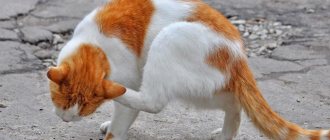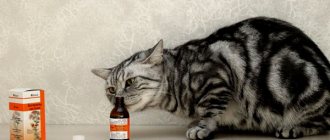Popular belief states that a cat has nine lives. True, this is just a belief. Specialists from the American Veterinary Insurance Society compiled a rating of the reasons for visiting clinics with cats. All kinds of wounds and injuries were on the seventh line of the gloomy “hot ten”. Not a single cat is immune from these diseases, and it is useful for the owner to know at least the basic rules and techniques for providing first aid to an injured pet. We talked about them with Doctor of Veterinary Sciences, Professor Sergei Aleksandrovich Yagnikov.
Most often, domestic cats suffer from wounds received in fights with fellow cats or dogs, as well as from the consequences of falling from a height. A non-specialist, based only on external signs of damage, can very rarely correctly assess the true nature of the injury and its danger to the life and health of the animal. Therefore, a responsible owner should not ignore any injury that occurs, even if it seems to him that the cat escaped with a few scratches and feels quite normal.
When to give your cat pain medication
Painkillers are given to animals in two cases: to relieve symptoms or to prevent their occurrence. In any case, the medicine is prescribed by a veterinarian. Pain is the body's reaction to an irritant. Each predator experiences suffering differently.
But there are a number of manifestations characteristic of all four-legged animals:
- a sharp change in behavior, the animal is too active or, on the contrary, passive;
- avoids communication, hides, shows aggression, hisses, scratches, tries to bite;
- restlessness: looking for a place, when he finds it he begins to “twirl”, trying to lie down comfortably;
- refusal to eat, does not even react to your favorite treat;
- ignores the litter box, trips to the toilet are accompanied by meowing;
- salivation, shortness of breath, rapid heartbeat.
Analgesics are prescribed in complex therapy for the following diseases:
- injuries, bruises, muscle strains;
- inflammatory processes in soft tissues;
- diseases of the joints and spine (arthritis, arthrosis);
- oncology;
- pathologies of the urinary system (urolithiasis, cystitis);
- pain syndromes after operations;
- abdominal muscle spasms caused by gastrointestinal diseases (constipation, bloating);
- neuralgia.
Glucocorticosteroids (hormonal)
Hormones have a strong anti-inflammatory effect, due to which pain goes away and swelling subsides. Such drugs are prescribed in tablets and ointments, and are also injected intramuscularly. But intra-articular injections work much faster and better. An additional advantage of steroids is the low risk of systemic adverse reactions, since they enter the blood in a negligibly small volume. Painkilling injections for joint pain are given with medications such as:
- flosterone;
- diprospan;
- kenalog;
- hydrocortisone;
- celeston.
Hormones are administered either individually or in combination with vitamins and local anesthetics (Lidocaine).
Attention! Steroids are useless and even dangerous for septic – infectious – arthritis. It is treated with antibiotics, which are administered only after the joint has been washed.
What painkiller can you give a cat: 10 safe drugs
Pharmaceutical veterinary products include thousands of pain relief products. When choosing a medication, not only the effectiveness, but also the harm caused is taken into account.
Relatively safe and effective medications:
- Vetalgin is an NSAID with analgesic and anti-inflammatory properties. Active pharmaceutical substance (API) diclofenac sodium. Prescribed as part of complex treatment for pathologies accompanied by inflammation and pain. Prohibited for kidney or liver problems, ulcers, or pregnancy.
- Quadrisol 5 is an NSAID for topical use. It is produced in the form of a gel containing vedaprofen. Used for acute and recurrent arthritis and arthrosis. Not prescribed for pets with kidney dysfunction, liver dysfunction, or gastrointestinal diseases.
- Rimadyl R is an NSAID with the API caprofen. Prescribed to relieve inflammation, analgesia in acute and chronic pathologies of the musculoskeletal system, after surgery. Prohibited for pregnant females.
- Ketonal is a long-acting NSAID. AFS ketoprofen. Prescribed for rheumatoid, psoriatic arthritis, arthrosis, gout, neuralgia. Helps with dental and cancer pain. Not prescribed for pathologies of the gastrointestinal tract, bleeding, renal failure.
- Meloxidil is an NSAID with an analgesic, anti-inflammatory, and anti-exudative effect. It is given for dislocations, arthrosis, edema, and tenosynovitis. Contraindicated in kittens under 6 weeks, pregnant females, hemorrhagic syndrome, stomach ulcers.
- Dexdomitor is an α2-adrenergic receptor antagonist. The active ingredient is dexmedetomidine hydrochloride. Causes depression of the central nervous system and an increase in the pain threshold. Prohibited for adults with heart failure, kidney dysfunction, and young animals under 3 months.
- Tramadol is an opiate analgesic prescribed to animals with cancer. Use with caution for liver and kidney dysfunction.
- Analgivet is a homeopathic remedy with the APS Aconitum napellus , which has no contraindications (with the exception of personal intolerance to the composition) and does not cause negative symptoms.
- Dexafort is a long-acting glucocorticosteroid. The active ingredient is dexamethasone. Prescribed to relieve post-traumatic swelling, joint pathologies, acute mastitis. Do not prescribe to animals with viral infections, osteoporosis, kidney damage, gastrointestinal tract.
- Ketofen is a French NSAID , it is a low-hazard drug and does not accumulate in the body. Indicated for arthrosis, injuries, dislocations, intervertebral hernias. Prohibited for stomach ulcers and kidney failure.
Be sure to read:
Dirofen deworming tablets: use for cats, dosage and composition
Medicines are given to pets only after consulting a doctor.
PRP therapy
PRP stands for platelet-rich plasma. Platrlet rich plasma. Platelets are responsible for the formation of blood clots - blood clots that can clog damaged blood vessels. Platelets also actively participate in the processes of cleansing wounds of unnecessary proteins and stimulate the activity of fibroblasts. The latter are responsible for the production of collagen and elastin, which are the basis of connective tissue.
PRP therapy is injections for joint pain that have a number of advantages:
- do not cause allergies or side effects;
- rarely lead to the development of complications; (hormones);
- vitamins;
- do not transmit infection..
These advantages are due to the use of the patient’s own blood, which is completely compatible with body tissues. To improve the effect, plasma administration can be combined with hyaluronic acid preparations.
Pain reliever for cats: how to give and how much
To relieve suffering, medications are given as prescribed by the doctor. In emergency cases, when independently calculating the dosage, follow the manufacturer’s recommendations.
| Name | dose calculation | course duration (in days) | mode of application |
| Vetalgin | 1 tablet per 2 kg | 5-7 | The medicine is given entirely during meals, 1-2 times a day. |
| Quadrisol 5 | 1 ml/10 kg | 14-28 | the solution is administered into the mouth or added to food once a day |
| Rimadyl R | tablet (20 mg) per 5 kg | 7 | the dose is divided in half, added to food in the morning and evening |
| Ketanol | 1 mg/kg | 5-7 | twice a day |
| Dexdomitor | 0.1 mg/kg | once in the clinic 12 hours before meals | |
| Meloxidil | 0.1 mg/kg | 10 | orally with food |
| Analgivet | 0.05-0.1 ml/kg | 5-7 | injections are given 1-2 times a day |
| Tramadol | The treatment regimen is selected individually | ||
| Dexafort | 0.05 ml/kg | once a week | administered intramuscularly or subcutaneously |
| Ketofen | 1 capsule (5 mg)/5 kg weight | 3-5 | once during meals |
The exact dosage and duration of use is determined by the veterinarian.
Hyaluronic acid
It is also called a “synovial fluid prosthesis”, since hyaluronic acid acts as a lubricant that protects the joint from injury. It normalizes the composition of the synovium, which becomes denser and more viscous. Hyaluronic acid perfectly relieves pain and inflammation, activates the processes of self-regeneration of cartilage. Its most common use is in patients with arthrosis. With this remedy, injections are often made into the hip joint and knees. The standard course of treatment consists of 3-5 procedures with a week interval between them. The effect lasts for a long time, up to 1 year. The most frequently prescribed drugs with “natural lubrication” are Gialgan, Hi-Flex, Gialsin.
Folk ways to relieve a cat from pain
To eliminate unpleasant symptoms, breeders resort to alternative methods. As independent methods, they are ineffective, but serve as a good addition to traditional therapy.
Veterinary pharmacology offers a number of homeopathic herbal remedies. Herbal medicines are not able to stop severe attacks, but will help the pet calm down.
You can prepare tea with a sedative effect yourself. Chamomile, lemon balm, and valerian are used as medicinal raw materials. To alleviate the condition of injuries, compresses are made from mountain arnica, a perennial daisy.
Herbal remedies are designed to stimulate the body's defense reactions. But when using the recipe for the first time, carefully monitor the condition of the four-legged animal. If there are any changes for the worse, the home remedy should be discontinued.
Be sure to read:
Vaccine Multifel 4 - instructions for cats, price and reviews
Among the alternative methods, the following have worked well:
- A massage will help your furry friend relax and improve blood circulation. Being surrounded by care, love and warmth from your hands will relieve stress. The manipulation is not carried out in severe conditions.
- Acupuncture helps in the treatment of arthritis, neuralgia, and inoperable tumors. The procedure will be performed by a specialist.
- Magnetotherapy relieves suffering, stimulates cell regeneration, reduces aggression, and increases appetite.
Non-traditional methods involve course therapy. The effect is achieved only after completing all procedures.
Useful tips
When packing a first aid kit for your cat, consider its age and health condition. If you have difficulty choosing the necessary products, consult your veterinarian.
Helpful Tips:
- When purchasing a kitten, ask in advance where the nearest veterinary clinic is located and write down the doctor’s contact number just in case;
- Vaccinate your cat against various diseases according to a special vaccination schedule;
- visit the veterinarian every three months for a preventive examination;
- carry out deworming and flea treatment following the instructions;
- accustom your kitten to the necessary hygienic care procedures from an early age;
- do not panic if your cat is sick or injured, provide the necessary assistance, acting in a coordinated and confident manner.
Be sure to read the instructions for each drug, study contraindications, and calculate the correct dosage before giving the drug to your domestic cat.
What painkillers are prohibited for cats?
If the animal is not feeling well, you should not give drugs that people take.
List of medications dangerous for animal representatives:
- Analgin changes the physical and chemical properties of blood, causing pathologies of the circulatory system (hydremia, anemia).
- Paracetamol poisons the liver, disrupts kidney function, puts a heavy load on the heart muscle, and provokes the development of methemoglobinamia.
- No-shpa causes paresis of the hind limbs; your furry friend may remain lame for life. Disturbances in the innervation of the paws quickly develop pathologies of the urinary system.
If your pet is given a prohibited medication, you should tell the veterinarian.
Advantages
- The drugs dissolve very slowly, up to 12 months.
- They have a local effect on all joint tissues.
- Almost do not enter the systemic circulation and do not affect the functioning of internal organs.
- Thanks to the previous point, they can be used in patients with severe concomitant pathologies, when treatment with other methods is unacceptable.
- Intra-articular injections help avoid surgery.
- After the procedure, no rehabilitation is required; the doctor can only apply a tight bandage and warn against excessive physical exertion.
First aid for burns
Under no circumstances should you remove dead skin or open blisters yourself, apply ice, butter, various ointments and medications to the burned area, or cover the burn with cotton bandages or adhesive tape. If you are burned by chemicals, you must remove part of the clothing on which the substance has come into contact and pour plenty of cool water over the affected area. For extensive burns, it is recommended to take a 10-minute shower or lie in a cool bath. After water procedures, it is important to pat your skin very carefully, put on loose clothing and see a doctor.
For a limited burn, it is necessary to place the burned area of skin under cold water for 10-15 minutes or apply a sterile ice pack; apply a sterile bandage; Give the patient a painkiller and if your health worsens, consult a doctor. For extensive burns, apply a loose sterile bandage; give an anesthetic and drink an alkaline-salt mixture (1 teaspoon of table salt and ½ teaspoon of baking soda, dissolved in 2 glasses of water), after providing first aid, take the victim to the hospital. In case of burns, a large amount of sodium ions leaves the vascular bed along with the plasma (0.5–0.6 mEq/% burn/kg of patient body weight). Therefore, fluid therapy, first of all, aims to fill the vascular bed and restore its sodium content.
Chemicals, with the exception of powdered ones, are washed off with water; Powdery substances must be brushed off after moistening them with water. Burns caused by acids, alkalis or organic substances (for example, phenols, cresols, petrochemical products) should be washed with copious amounts of water, and the burn area should be washed for at least 20 minutes.











